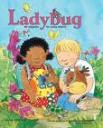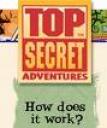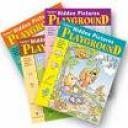
Magazines for Kids (from a magazine junkie’s perspective)
It seems like I’m always writing about books, an article I read here, a website I found there. I guess that says something about how I like to spend some of my free time (escape from the kids time).
Instead of writing about some enjoyable reading resource for us moms, I thought I would write about magazines for kids this week. My mom loves to spoil the kids and she has ordered us some subscriptions to some fun magazines. I thought I’d give a review on the ones we have received in case you were looking for some fun reading material for your own kids. They also make great gifts for others if you are looking for something a little educational and fun that lasts all year long.

1. Ladybug Magazine- We were given a bagful of some old magazines by our neighbor who had read and reread them to several of her
children. I had never heard of Ladybug before, but I gotta tell you that my 4 and 5 year old LOVE them. We had a stack of about 20-30 magazines and we have read them so many times that they can look at the covers and know what is inside. Ladybug is a great magazine for preschoolers and toddlers. Each magazine usually focuses on some kind of theme, like rain, and will incorporate rain into several of the stories. The magazine is full of short stories, one or two longer stories, a song, some poems, and two cartoons that are simple-with easy to love characters. When my mom came to visit she read several of the magazines to them and decided to order a subscription. They squeal with delight when one comes in the mail.
 2. Zootles- Another good find. Zootles is a magazine for 2-5 year olds. It focuses on on animal and has several stories, pictures, and facts about the animal of the month. It also introduces a letter and a number in each issue. A one year subscription provides 6 issues since it only comes out every other month. The kids also enjoyed this one and learned a lot about animals.
2. Zootles- Another good find. Zootles is a magazine for 2-5 year olds. It focuses on on animal and has several stories, pictures, and facts about the animal of the month. It also introduces a letter and a number in each issue. A one year subscription provides 6 issues since it only comes out every other month. The kids also enjoyed this one and learned a lot about animals.
 3. Zoobooks- Is made by the same company as Zootles but is geared for older kids. The stories and information in the magazines is more complex. The kids also had this magazine for a while. They really enjoyed it.
3. Zoobooks- Is made by the same company as Zootles but is geared for older kids. The stories and information in the magazines is more complex. The kids also had this magazine for a while. They really enjoyed it.
 4. National Geographic Kids- This is a fun magazine too but it is definitely geared for kids 7 and up. I actually enjoy reading this one more than my kids do–but I imagine that it is entertaining for kids in the right age group. The magazine has fun articles about living green and how kids can contribute to caring for the earth. It has funny jokes, wild and interesting facts, amazing but true stories about animals, movie reviews from a kid’s perspective, and lots of ads for video games (that part I don’t like so much).
4. National Geographic Kids- This is a fun magazine too but it is definitely geared for kids 7 and up. I actually enjoy reading this one more than my kids do–but I imagine that it is entertaining for kids in the right age group. The magazine has fun articles about living green and how kids can contribute to caring for the earth. It has funny jokes, wild and interesting facts, amazing but true stories about animals, movie reviews from a kid’s perspective, and lots of ads for video games (that part I don’t like so much).
 5. Kids Discover- Is geared for 7-12 year olds. Another gift from my mom. I think she was trying to give them something that was interesting and educational. I have to say it was a flop–but they were just too young. Again, I enjoyed reading it more than the kids. If the boys were a few years older, I think they would enjoy some of the magazines a lot. We did sit down and read the last issue together because it was about chocolate. And who doesn’t love chocolate? We were all fascinated about the science of how chocolate is made and where it comes from. This magazine would make a great addition to any homeschooling family!
5. Kids Discover- Is geared for 7-12 year olds. Another gift from my mom. I think she was trying to give them something that was interesting and educational. I have to say it was a flop–but they were just too young. Again, I enjoyed reading it more than the kids. If the boys were a few years older, I think they would enjoy some of the magazines a lot. We did sit down and read the last issue together because it was about chocolate. And who doesn’t love chocolate? We were all fascinated about the science of how chocolate is made and where it comes from. This magazine would make a great addition to any homeschooling family!
 6. Highlights Top Secret Adventures- This one showed up in our mailbox and we were all intrigued. A new package comes in the mail every month and the kids squeal again when they see it. Top Secret Adventures is a kit that includes a small puzzle of a country, a book about the country containing facts and information about the culture, people, regions, major cities, language, and food. It also includes a puzzle book where you enter a journey as a top secret agent trying to figure out who the crook is, what they stole, and where it is hidden. The puzzles teach kids how to think critically and logically. I’m sure you can tell by the sound of it, that is is not geared toward the preschool ages but my kids love it. We sit and do it together. They of course, need help with all the reading but there are some puzzles they can do without our help and we have noticed in the last few months that they are able to understand and do more without so much help from us. It is something I would enjoy doing by myself too!
6. Highlights Top Secret Adventures- This one showed up in our mailbox and we were all intrigued. A new package comes in the mail every month and the kids squeal again when they see it. Top Secret Adventures is a kit that includes a small puzzle of a country, a book about the country containing facts and information about the culture, people, regions, major cities, language, and food. It also includes a puzzle book where you enter a journey as a top secret agent trying to figure out who the crook is, what they stole, and where it is hidden. The puzzles teach kids how to think critically and logically. I’m sure you can tell by the sound of it, that is is not geared toward the preschool ages but my kids love it. We sit and do it together. They of course, need help with all the reading but there are some puzzles they can do without our help and we have noticed in the last few months that they are able to understand and do more without so much help from us. It is something I would enjoy doing by myself too!
 7. Highlights Hidden Pictures Playground- If you have kids who love stickers, like to draw, and maybe do seek and find pictures then this is a good magazine. My kids aren’t into it very much though. I’m not sure why but I think it is because they don’t love to color. I usually do bring the magazines with us on long car rides or plane trips to give them something to do for a while. They don’t squeal with delight when it comes in the mail or piles up in their book corner but it does provide something different to do while we are traveling.
7. Highlights Hidden Pictures Playground- If you have kids who love stickers, like to draw, and maybe do seek and find pictures then this is a good magazine. My kids aren’t into it very much though. I’m not sure why but I think it is because they don’t love to color. I usually do bring the magazines with us on long car rides or plane trips to give them something to do for a while. They don’t squeal with delight when it comes in the mail or piles up in their book corner but it does provide something different to do while we are traveling.
 8. God’s World News Early Edition- Is a gift from my in-laws. I have found it to be interesting and enjoyable too. The magazine covers a broad spectrum of stories happening around the world. It touches on animals, history, science, culture all through the perspective that God cares about our world and what happens in it. Young readers or preschoolers will like looking at the pictures and reading some of the simple stories in it. There are sections marked for parents to read to children (who are too young to read themselves). It also has a few puzzle games in it for a fun follow up activity.
8. God’s World News Early Edition- Is a gift from my in-laws. I have found it to be interesting and enjoyable too. The magazine covers a broad spectrum of stories happening around the world. It touches on animals, history, science, culture all through the perspective that God cares about our world and what happens in it. Young readers or preschoolers will like looking at the pictures and reading some of the simple stories in it. There are sections marked for parents to read to children (who are too young to read themselves). It also has a few puzzle games in it for a fun follow up activity.
Wow, I didn’t realize that we had so many subscriptions in the past few years until writing them down. Do you get any magazines for your kids? Which ones? Had any bombs? Which ones? Don’t be shy–share your opinion!
Share the fun: Email + Del.icio.us + Digg + Technorati

 “Mo-om, can I play on the computer?” How many of you hear that everyday?
“Mo-om, can I play on the computer?” How many of you hear that everyday?


 You get the idea. The key is to make sure that you offer two choices and that you are fine with either choice. The other thing to keep in mind is to make sure the second choice is not a threat (i.e. do you want to clean up the toys or do you want a spanking?)
You get the idea. The key is to make sure that you offer two choices and that you are fine with either choice. The other thing to keep in mind is to make sure the second choice is not a threat (i.e. do you want to clean up the toys or do you want a spanking?)
 Drill Sergeant Parents believe that they can make their children do whatever the parent says to do. Drill Sergeant parenting incorporates threats and punishment in order to make the child do what the parent wants.
Drill Sergeant Parents believe that they can make their children do whatever the parent says to do. Drill Sergeant parenting incorporates threats and punishment in order to make the child do what the parent wants. 






